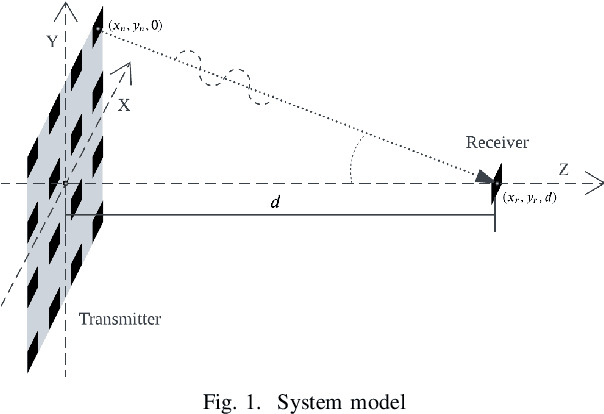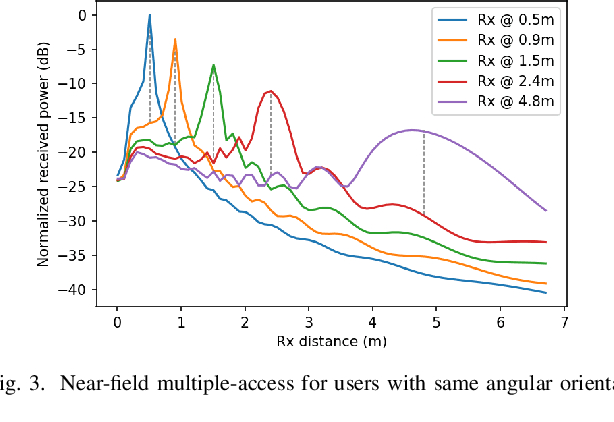Ehsan Tohidi
RIS-assisted Physical Layer Security
Jan 30, 2025



Abstract:We propose a reconfigurable intelligent surface (RIS)-assisted wiretap channel, where the RIS is strategically deployed to provide a spatial separation to the transmitter, and orthogonal combiners are employed at the legitimate receiver to extract the data streams from the direct and RIS-assisted links. Then we derive the achievable secrecy rate under semantic security for the RIS-assisted channel and design an algorithm for the secrecy rate optimization problem. The simulation results show the effects of total transmit power, the location and number of eavesdroppers on the security performance.
An Optimization Driven Link SINR Assurance in RIS-assisted Indoor Networks
Dec 28, 2024Abstract:Future smart factories are expected to deploy applications over high-performance indoor wireless channels in the millimeter-wave (mmWave) bands, which on the other hand are susceptible to high path losses and Line-of Sight (LoS) blockages. Low-cost Reconfigurable Intelligent Surfaces (RISs) can provide great opportunities in such scenarios, due to its ability to alleviate LoS link blockages. In this paper, we formulate a combinatorial optimization problem, solved with Integer Linear Programming (ILP) to optimally maintain connectivity by solving the problem of allocating RIS to robots in a wireless indoor network. Our model exploits the characteristic of nulling interference from RISs by tuning RIS reflection coefficients. We further consider Quality-of-Service (QoS) at receivers in terms of Signal-to-Interference-plus-Noise Ratio (SINR) and connection outages due to insufficient transmission quality service. Numerical results for optimal solutions and heuristics show the benefits of optimally deploying RISs by providing continuous connectivity through SINR, which significantly reduces outages due to link quality.
Towards Bridging the Gap between Near and Far-Field Characterizations of the Wireless Channel
Mar 10, 2024


Abstract:The "near-field" propagation modeling of wireless channels is necessary to support sixth-generation (6G) technologies, such as intelligent reflecting surface (IRS), that are enabled by large aperture antennas and higher frequency carriers. As the conventional far-field model proves inadequate in this context, there is a pressing need to explore and bridge the gap between near and far-field propagation models. Although far-field models are simple and provide computationally efficient solutions for many practical applications, near-field models provide the most accurate representation of wireless channels. This paper builds upon the foundations of electromagnetic wave propagation theory to derive near and far-field models as approximations of the Green's function (Maxwell's equations). We characterize the near and far-field models both theoretically and with the help of simulations in a line-of-sight (LOS)-only scenario. In particular, for two key applications in multiantenna systems, namely, beamforming and multiple-access, we showcase the advantages of using the near-field model over the far-field, and present a novel scheduling scheme for multiple-access in the near-field regime. Our findings offer insights into the challenge of incorporating near-field models in practical wireless systems, fostering enhanced performance in future communication technologies.
Revisiting Matching Pursuit: Beyond Approximate Submodularity
May 12, 2023



Abstract:We study the problem of selecting a subset of vectors from a large set, to obtain the best signal representation over a family of functions. Although greedy methods have been widely used for tackling this problem and many of those have been analyzed under the lens of (weak) submodularity, none of these algorithms are explicitly devised using such a functional property. Here, we revisit the vector-selection problem and introduce a function which is shown to be submodular in expectation. This function does not only guarantee near-optimality through a greedy algorithm in expectation, but also alleviates the existing deficiencies in commonly used matching pursuit (MP) algorithms. We further show the relation between the single-point-estimate version of the proposed greedy algorithm and MP variants. Our theoretical results are supported by numerical experiments for the angle of arrival estimation problem, a typical signal representation task; the experiments demonstrate the benefits of the proposed method with respect to the traditional MP algorithms.
D-Band RIS as a Reflect Array: Characterization and Hardware Impairments Study
May 10, 2023



Abstract:Reflecting intelligent surface (RIS) has emerged as a promising technology for enhancing wireless communication performance and enabling new applications in 6G networks with potentially low energy consumption and hardware complexity thanks to their passive nature. Despite the significant growth of the literature on RIS in recent years, covering various aspects of this technology, challenges and issues regarding the practical implementation of RIS have been less addressed. This issue is even more severe at D-band frequencies due to the inherent challenges. This paper aims to connect the requirements and aspirations from the link-level side to the actually achievable RIS hardware with the focus on the various models for RIS. In order to obtain a realistic hardware scenario while maintaining a manageable parameter set, a static reflect array with similar reflection behavior as the reconfigurable one is employed. The results of the study enable an improved RIS design process due to more realistic models. The special focus of this paper is on the hardware impairments, in particular, (i) the effect of specular reflection, and (ii) the beam squint effect.
Near-Optimal LOS and Orientation Aware Intelligent Reflecting Surface Placement
May 05, 2023Abstract:Due to their passive nature and thus low energy consumption, intelligent reflecting surfaces (IRSs) have shown promise as means of extending coverage as a proxy for connection reliability. The relative locations of the base station (BS), IRS, and user equipment (UE) determine the extent of the coverage that the IRS provides which demonstrates the importance of the IRS placement problem. More specifically, locations, which determine whether BS-IRS and IRS-UE line of sight (LOS) links exist, and surface orientation, which determines whether the BS and UE are within the field of view (FoV) of the surface, play crucial roles in the quality of provided coverage. Moreover, another challenge is high computational complexity, since the IRS placement problem is a combinatorial optimization, and is NP-hard. Identifying the orientation of the surface and LOS channel as two crucial factors, we propose an efficient IRS placement algorithm that takes these two characteristics into account in order to maximize the network coverage. We prove the submodularity of the objective function which establishes near-optimal performance bounds for the algorithm. Simulation results demonstrate the performance of the proposed algorithm in a real environment.
MIMO Systems with Reconfigurable Antennas: Joint Channel Estimation and Mode Selection
Nov 24, 2022Abstract:Reconfigurable antennas (RAs) are a promising technology to enhance the capacity and coverage of wireless communication systems. However, RA systems have two major challenges: (i) High computational complexity of mode selection, and (ii) High overhead of channel estimation for all modes. In this paper, we develop a low-complexity iterative mode selection algorithm for data transmission in an RA-MIMO system. Furthermore, we study channel estimation of an RA multi-user MIMO system. However, given the coherence time, it is challenging to estimate channels of all modes. We propose a mode selection scheme to select a subset of modes, train channels for the selected subset, and predict channels for the remaining modes. In addition, we propose a prediction scheme based on pattern correlation between modes. Representative simulation results demonstrate the system's channel estimation error and achievable sum-rate for various selected modes and different signal-to-noise ratios (SNRs).
Machine Learning-based Methods for Reconfigurable Antenna Mode Selection in MIMO Systems
Nov 24, 2022Abstract:MIMO technology has enabled spatial multiple access and has provided a higher system spectral efficiency (SE). However, this technology has some drawbacks, such as the high number of RF chains that increases complexity in the system. One of the solutions to this problem can be to employ reconfigurable antennas (RAs) that can support different radiation patterns during transmission to provide similar performance with fewer RF chains. In this regard, the system aims to maximize the SE with respect to optimum beamforming design and RA mode selection. Due to the non-convexity of this problem, we propose machine learning-based methods for RA antenna mode selection in both dynamic and static scenarios. In the static scenario, we present how to solve the RA mode selection problem, an integer optimization problem in nature, via deep convolutional neural networks (DCNN). A Multi-Armed-bandit (MAB) consisting of offline and online training is employed for the dynamic RA state selection. For the proposed MAB, the computational complexity of the optimization problem is reduced. Finally, the proposed methods in both dynamic and static scenarios are compared with exhaustive search and random selection methods.
 Add to Chrome
Add to Chrome Add to Firefox
Add to Firefox Add to Edge
Add to Edge